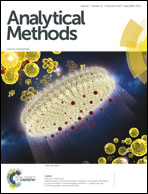A voltammetric sensor based on multi-walled carbon nanotube–MnO2 nanowire composite film for simultaneous determination of hydroquinone and catechol
Abstract
A simple and sensitive electrochemical method for the simultaneous detection of hydroquinone (HQ) and catechol (CC) was developed, based on a multi-walled carbon nanotube and MnO2 nanowire composite (MWCNTs–MnO2) modified glassy carbon electrode (GCE). Electrochemical impedance spectra studies showed a small charge transfer resistance (Rct) for the MWCNTs–MnO2 composite film due to the incorporation of MWCNTs. Compared with the bare GCE, both HQ and CC exhibited well-defined redox peaks and much larger peak currents at MWCNTs–MnO2/GCE, which was related to the higher specific surface area and catalysis rate of the MWCNTs–MnO2 film. The MnO2 film acted as an electron transfer mediator to accelerate the electron transfer rate for the oxidation of HQ and CC. Due to the large separation of oxidation peak potentials (102 mV), the concentrations of HQ and CC can be easily determined simultaneously. The oxidation peak currents were linear to HQ/CC in the range from 5 × 10−7 to 8 × 10−5 M with the detection limits of 5 × 10−8 M (S/N = 3) for HQ and 8 × 10−8 M (S/N = 3) for CC. Simultaneous determination of HQ and CC with such an electrode was conducted in tap water samples with reliable recovery.


 Please wait while we load your content...
Please wait while we load your content...